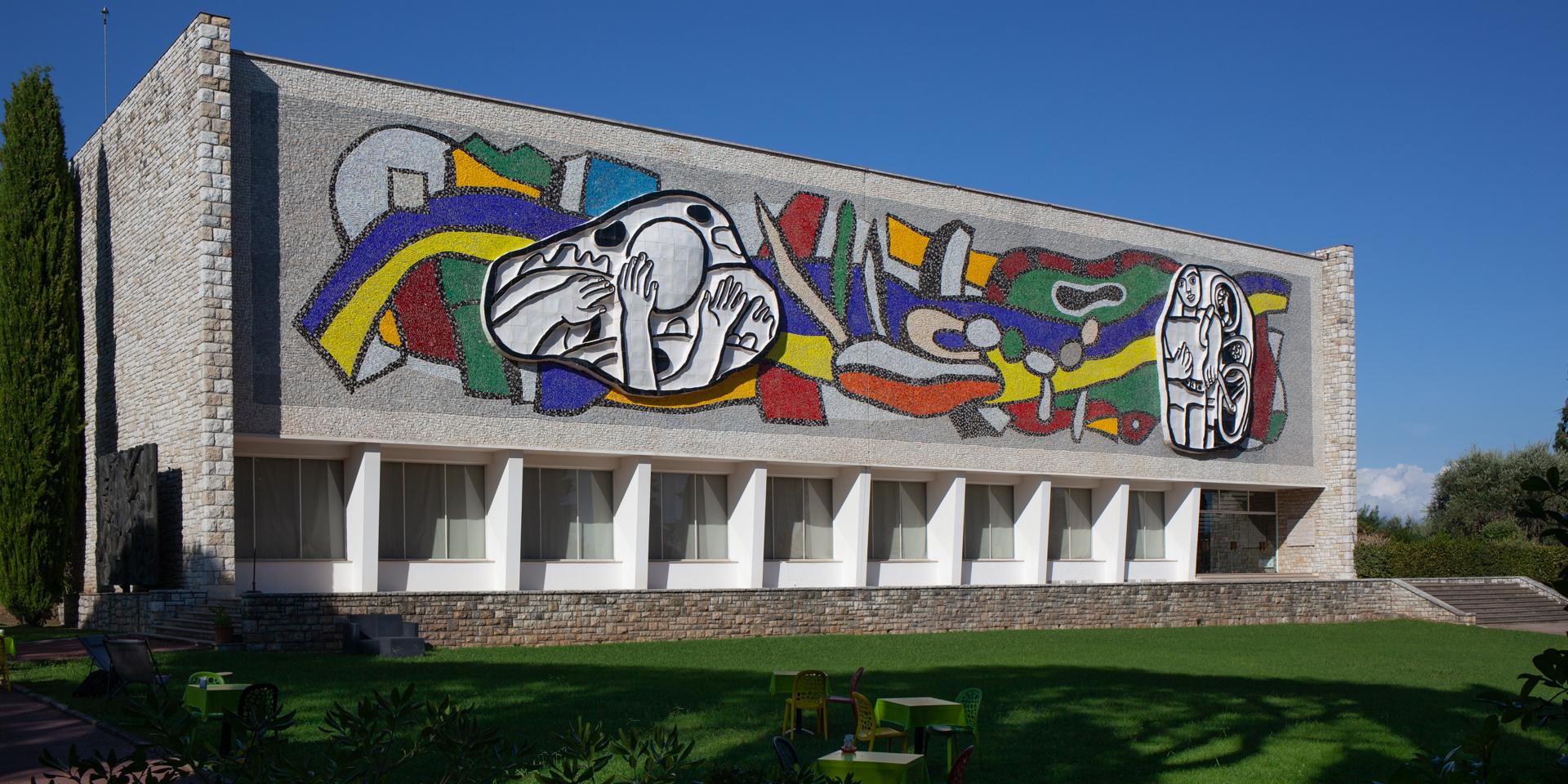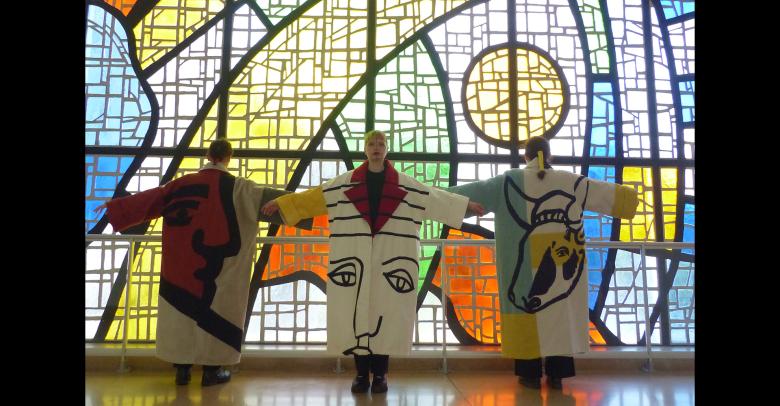The restoration of the main façade of the Léger Museum in 2015 is an opportunity to tell the original story of the monumental work that decorates it, from its conception in 1954 for a German building to the technical feat that the current restoration represents.
The history of the monumental work
In 1949, Fernand Léger began producing bas-reliefs and ceramic sculptures in the Biot workshop of Roland and Claude Brice. A few months before his death in 1955, he acquired a property at the foot of the village of Biot, the Mas Saint-André, with a view to installing in the gardens the large polychrome ceramic sculptures he was planning at the time. His widow Nadia Léger and Georges Bauquier, Fernand Léger's friend and assistant, decided to build a museum dedicated to the artist between 1957 and 1960 on this land. They commissioned the architect André Svetchine to build the museum. To decorate its main façade, they asked him to adapt an unfinished project by Léger commissioned by the city of Hanover in Germany and initially planned for the new velodrome stadium. It was therefore finally in Biot that this project saw the light of day.
The Fernand Léger Museum was inaugurated on 13 May 1960, the first museum of modern art built on the Côte d'Azur. Its reception as a functional and exceptional building was celebrated by the national and international press. In 1969, the founders of the museum, Nadia Léger and Georges Bauquier, donated to the French State the prestigious museum, the land laid out as a Mediterranean park, and a collection of more than three hundred works chosen to illustrate the importance of the painter's career in 20th century art. It was André Malraux, Minister of Culture, who received the keys to the Fernand Léger Museum on the spot, thus marking the museum's becoming a national museum.
The architecture of the museum is simple and effective. The building is designed as a support for a monumental decoration in the upper part of its main façade. This unique monumental decoration of 395 m² is made of mosaic and completed with two ceramic high reliefs. The highly graphic polychrome mosaic created by Lino and Heidi Mélano in association with Luigi Guardigli forms an abstract coloured background in tesserae of three to five centimetres on each side. As the day progresses, and depending on the amount of sunlight, the coloured glass paste tesserae glitter with a thousand lights. On this luminous polychrome background are integrated two high reliefs of white glazed ceramic, whose motifs, highlighted in black, were created in Roland Brice's workshop in Biot. The mosaicists and ceramists were outstanding interpreters of Léger's sketches for the Hanover stadium, and at the time they accomplished a technical feat. The evocation of sport (ball games and bicycles), the two frescoes in white and black enamel on the colourful mosaic, all speak of pleasure and joie de vivre.
In close collaboration with the architect André Svetchine, the landscape designer Henri Fisch has reinforced the contrast between the green vegetation and the bright colours of the monumental work. Deliberately sober, the park, planted with Mediterranean species, is, in all seasons, a very pleasant shaded walk which offers multiple points of view on the museum and Fernand Léger's monumental sculpture, Le Jardin d'enfants.
The building, which was designated a 20th century heritage site by the Ministry of Culture and Communication in 2001, is one of the rare visible examples of Fernand Léger's monumental decorative aesthetic. Like a visual signal, the façade seems to call out to the public and invite them to experience painting in the public space, a colourful backdrop for convivial outdoor activities.
Behind the scenes of the restoration of the monumental work
The large size of the almost 400 m2 façade, its southern exposure and the interaction between the various materials of which it is composed are responsible for the damage and alterations noted since the 1970s (detachment of elements, cracking of the ceramics, falling of certain elements, etc.). At the end of the 1990s, the ceramics had to be put under a net because of their condition. After numerous studies, a restoration project was planned. This restoration was entrusted in 2013 to the agency Pierre-Antoine Gatier, chief architect of the Monuments Historiques, and began in 2014. This ambitious project is as much a technical feat as the initial work. It will be completed in July 2015. The work was entrusted to the company Socra, which specialises in the restoration of historic monuments. The work first involved the removal of the 413 ceramic modules by sawing. After restoration in the workshop of each ceramic (and the refurbishment of 16 non-restorable modules), each module is reassembled on a new honeycomb support and then hung on a rail on the façade. The total cost of the work is 343,773 euros, including tax.
A fun and interactive exhibition
Designed for a wide audience, the exhibition presents the history of this decorative façade in a playful way. Tactile tables provide a visual and sensual understanding of the materials and their use in the façade. The stages of the restoration are presented by means of 3D images, photographs of the building site and filmed interviews with professionals such as architects, restorers and the museum's scientific staff. Finally, the floor is given to visitors of all ages as well as to 5 artists (Max Charvolen, Martin Miguel, Noël Dolla, Jean-Paul van Lith, Emmanuelle Villard). The free view they take of Fernand Léger's monumental work, now renovated, reveals its modernity and poetry.
Consult the press kit of the exhibition:
Légende : Détail de la façade sud du musée national Fernand Léger,1960 ,Mosaïque et céramique réalisées d’après un projet de décoration murale de Fernand Léger, restaurées en 2014 © photo Ville de Biot © Adagp, Paris 2015
Open every day except Tuesdays, 1 January, 1 May and 25 December.
From May to October
from 10am to 6pm
From November to April
from 10am to 5pm
Full price: 6.50 €
Reduced rate: 5€
Group rate: 6 € (from 10 people)


